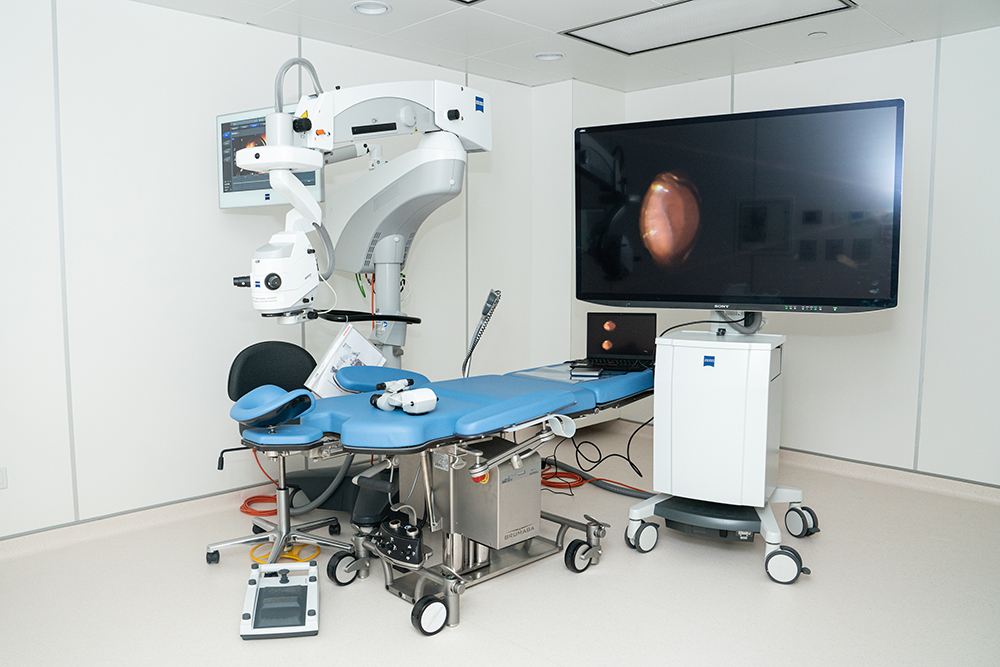November 2022 | Volume 24 No. 1
The Eyes Have It
Cataracts are a common disease of the eye affecting vision especially among older people. The problem is easily cured, but in Hong Kong the wait for cataract surgery in the public health system is among the longest in the developed world, at three to four years. During that time, vision gets worse.
Now, two initiatives launched through the new HKU Eye Centre, operated by the Department of Ophthalmology, will provide some relief to patients most in need.
With funding support from Sun Hung Kai, the HKU Eye Centre is providing free eye examinations and cataract surgery to socially disadvantaged patients identified by the Hong Kong Sheng Kung Hui Welfare Council, with the aim of providing about 500 cataract surgeries.
And by the end of the year, the HKU Eye Centre will launch a one-year programme with Orbis, a non-governmental organisation with international programmes focussed on the prevention of blindness and the treatment of blinding eye diseases, to provide eye checks to about 3,000 residents living in public housing estates across Hong Kong. This will also give researchers an idea of the prevalence of blindness and other eye diseases such as glaucoma, using technologies developed at HKU.
“We can examine these patients with advanced ophthalmic investigations and at the same time the investigation results will benefit our research,” said Professor Christopher Leung Kai-shun, Head of Ophthalmology.
New centre is a catalyst
The catalyst for these initiatives has been the opening of the new HKU Eye Centre near Wong Chuk Hang MTR station, which has three consultation rooms, two operating theatres, an opticians’ area and high-end equipment that is being used to pursue impactful translational research. The centre consolidates the work of ophthalmology at HKU in ways that were not possible before.
“We used to be scattered across different areas of southern Hong Kong to provide ophthalmic care for our patients, but now we have our equipment and staff mostly in one place. We are now able to combine resources not just in terms of hardware and manpower, but also patients,” Professor Leung said.
Ophthalmology is a relatively new speciality in the Li Ka Shing Faculty of Medicine and only became its own department in 2012. Teaching, research and patient care have taken place at Grantham Hospital, Queen Mary Hospital and Gleneagles Hospital (for private patients) and while these activities will continue, the HKU Eye Centre consolidates research in particular and gives the Department more autonomy in research and charity programmes.
For instance, it has developed a new tool, called ROTA for Retinal nerve fibre layer Optical Texture Analysis, that can measure the trajectories and optical texture signals of nerve fibres in the eye, which is important for diagnosing glaucoma and other forms of optic nerve diseases. This has been patented and is being licensed to other parts of the world.
They are also working with Topcon Corporation of Japan to look at small vessels of the eye, the outcome of which could have implications beyond ophthalmology. “If the small vessel becomes blocked, you can have a stroke of the eye, just like you might have a heart attack or stroke when a major artery is blocked. In years to come, we hope to look at whether there is potential in developing this technology as a biomarker to predict who might develop cardiovascular or cerebrovascular diseases. The eye is the only organ where we can visualise the blood vessels and nerves in vivo, meaning without any cutting or dissection,” he said.

The HKU Eye Centre is equipped with state-of-the-art facilities, including optical biometry, cornea/anterior segment optical coherence tomography and 3D digital surgical microscope.
Teaching benefits
The HKU Eye Centre uses its advanced equipment to benefit patients from all walks of life. Its academic staff have both public and private patients, as well as charity patients.
Teaching will also be supported at the centre. Professor Leung said the Department recently entered into a collaboration with Kowloon East cluster that will give students exposure to patients from a broader socioeconomic spectrum than they might find on Hong Kong Island South. “We expect the diseases may be more severe or they will have more complicated types of disease and other medical conditions,” he said.
He noted this was the first HKU clinical services centre outside campus not affiliated with a hospital. This is possible because 95 per cent of ophthalmic surgeries are performed in day-care centres. “A cataract surgery, for instance, is a relatively straightforward procedure nowadays and takes 10 or 15 minutes. We can generate this kind of immediate impact,” he said.
Getting the HKU Eye Centre and various programmes up and running has been a whirlwind ride for Professor Leung, who joined HKU in March 2021. He said it would not be possible without the support of HKUMed, HKU’s Estates Office and Finance and Enterprises Office, and Sun Hung Kai. “This has really been a huge opportunity,” he said.
Learn more about the HKU Eye Centre here.
We can examine these patients with advanced ophthalmic investigations and at the same time the investigation results will benefit our research.

PROFESSOR CHRISTOPHER LEUNG KAI-SHUN

